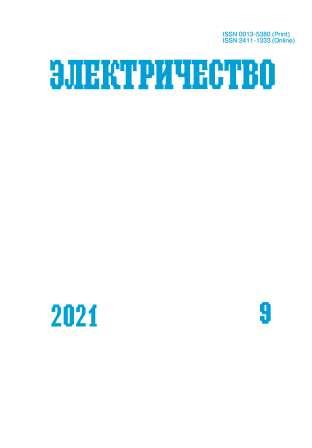Optimization of the Mongolia Backbone Electric Grid Development
DOI:
https://doi.org/10.24160/0013-5380-2021-9-58-66Keywords:
electric power industry, electric network, inter-area links, mathematical model, development optimizationAbstract
The central electric power system of Mongolia is characterized by a disjointed structure of its generating capacities, the existence of isolated "islanded" power systems, a significant length of inter-area transmission lines, and the availability of links with the power systems of Russia and China. The article discusses the current state and prospects for the development of the Central Power System of Mongolia. The long-term development of the power system requires multi-scenario studies and optimization calculations, which require dedicated mathematical models. An optimization mathematical model of the electric network has been developed, which is based on determining the minimum discounted costs for the construction and operation of new power lines subject to conditions and constraints relating for electricity generation and consumers. By using the optimization model, the development of the power system's backbone electric grid for the period up to 2030 is analyzed. The need of the Mongolian power industry for construction of six backbone power lines that will make it possible to unite the country's isolated power systems and optimize the load flow distribution in the network is pointed out. The correctness of the obtained results is confirmed by modeling and conducting comparative calculations of the electric network in the RastrWin software package.
References
2. Лукина Г.В., Бондаренко С.И., Тумэннаст Г. Состояние электроэнергетики Монголии. – Вестник ИрГСХА, 2011, № 46, с. 86–92.
3. Такайшвили Л.Н., Соколов А.Д., Батхуяг С. Перспективы развития угольной энергетики Монголии. – Вестник Иркутского государственного технического университета, 2019, № 1, с. 137–147.
4. Воропай Н.И., Подковальников С.В., Труфанов В.В. Обоснование развития электроэнергетических систем: методология, модели, методы, их использование. Новосибирск: Наука, 2015, 448 с.
5. Труфанов В.В. Моделирование развития основной электрической сети в условиях рынка. – Вестник Иркутского государственного технического университета, 2013, № 3, с. 117–122.
6. Драчев П.С. Рыночная модель развития основной электрической сети. – Вестник Иркутского государственного технического университета, 2013, № 1, с. 125–134.
7. Ковалев Г.Ф., Воропай Н.И. Учет фактора надежности при оценке системных эффектов в электроэнергетике. Новосибирск: Наука, 2018, 217 с.
8. Воропай Н.И. Иерархическое моделирование при обосновании развития электроэнергетических систем. – Exponenta Pro. Математика в приложениях, 2003, № 4, с. 24–27.
9. Труфанов В.В., Драчев П.С. Оценка существующего энергетического потенциала регионов России. – Вестник Иркутского государственного технического университета, 2019, т. 23, № 5, с. 967–977.
10. Drachev P.S., Trufanov V.V. Market-based transmission expansion planning. – Energy and Power Engineering, 2012, vol. 4, No. 6, pp. 387–392.
11. Драчев П.С. Совершенствование методики обоснования перспективного развития системообразующей электрической сети: дис … канд. техн. наук. Иркутск, 2017, 160 с.
12. Труфанов В.В., Ханаев В.В. Оптимизация сценариев развития и размещения генерирующих мощностей и требований к пропускной способности межсистемных связей ЭЭС. – Электроэнергия. Передача и распределение, 2020, № 5, с. 60–62.
13. Труфанов В.В., Ханаев В.В. Математическое моделирование потребителей электроэнергии при оптимизации развития электроэнергетических систем. – Электричество, 2008, № 9, с. 2–9.
14. Voropai N.I., Efimov D.N., Khanaev V.V. Demand side management and load control in Russia: Experience and perspective view for the next two decades. – IEEE PES General Meeting, 2010, DOI: 10.1109/PES.2010.5588122.
15. Воропай Н.И., Труфанов В.В. Математическое моделирование развития электроэнергетических систем в современных условиях. – Электричество, 2000, № 10, с. 6–13.
16. Воропай Н.И. Системные исследования в энергетике: ретроспектива научных направлений СЭИ – ИСЭМ. Новосибирск: Наука, 2010, 686 с.
#
1. Lukina G.V., Tumennast G. Vestnik Irkutskogo gosudarstven-nogo tekhnicheskogo universiteta – in Russ. (Bulletin of the Irkutsk State Technical University), 2011, No. 6, pp. 127–129.
2. Lukina G.V., Bondarenko S.I., Tumennast G. Vestnik IrGSKhA – in Russ. (Vestnik IrGSHA), 2011, No. 46, pp. 86–92.
3. Takayshvili L.N., Sokolov A.D., Bathuyag S. Vestnik Irkutskogo gosudarstvennogo tekhnicheskogo universiteta – in Russ. (Bulletin of the Irkutsk State Technical University), 2019, No. 1, pp. 137–147.
4. Voropay N.I., Podkoval'nikov S.V., Trufanov V.V. Obosno-vanie razvitiya elektroenergeticheskih sistem: metodologiya, modeli, metody, ih ispol'zovanie (Justification of the development of electric power systems: methodology, models, methods, their use). Novosibirsk: Nauka, 2015, 448 p.
5. Trufanov V.V. Vestnik Irkutskogo gosudarstvennogo tekhni-cheskogo universiteta – in Russ. (Bulletin of the Irkutsk State Technical University), 2013, No. 3, pp. 117–122.
6. Drachev P.S. Vestnik Irkutskogo gosudarstvennogo tekhni-cheskogo universiteta – in Russ. (Bulletin of the Irkutsk State Technical University), 2013, No. 1, с. 125–134.
7. Kovalev G.F., Voropay N.I. Uchet faktora nadezhnosti pri otsenke sistemnyh effektov v elektroenergetike (Taking into account the reliability factor when evaluating system effects in the electric power industry). Novosibirsk: Nauka, 2018, 217 p.
8. Voropay N.I. Exponenta Pro. Matematika v prilozheniyah – in Russ. (Exponenta Pro. Mathematics in applications), 2003, No. 4, pp. 24–27.
9. Trufanov V.V., Drachev P.S. Vestnik Irkutskogo gosudarstven-nogo tekhnicheskogo universiteta – in Russ. (Bulletin of the Irkutsk State Technical University), 2019, vol. 23, No. 5, pp. 967–977.
10. Drachev P.S., Trufanov V.V. Market-based transmission expansion planning. – Energy and Power Engineering, 2012, vol. 4, No. 6, pp. 387–392.
11. Drachev P.S. Sovershenstvovanie metodiki obosnovaniya perspektivnogo razvitiya sistemoobrazuyushchey elektricheskoy seti: dis … kand. tekhn. nauk (Improvement of the methodology for sub-stantiating the future development of the backbone electrical network: Dis … Cand. Sci (Eng.)). Irkutsk, 2017, 160 p.
12. Trufanov V.V., Khanaev V.V. Elektroenergiya. Peredacha i raspredelenie – in Russ. (Electricity. Transmission and distribution), 2020, No. 5, pp. 60–62.
13. Trufanov V.V., Khanaev V.V. Elektrichestvo – in Russ. (Elec-tricity), 2008, No. 9, pp. 2–9.
14. Voropai N.I., Efimov D.N., Khanaev V.V. Demand side management and load control in Russia: Experience and perspective view for the next two decades. – IEEE PES General Meeting, 2010, DOI: 10.1109/PES.2010.5588122.
15. Voropay N.I., Trufanov V.V. Elektrichestvo – in Russ. (Electricity), 2000, No. 10, pp. 6–13.
16. Voropay N.I. Sistemnye issledovaniya v energetike: retrospek-tiva nauchnyh napravleniy SEI – ISEM (Systems research in energy: a retrospective of the scientific directions of SEI – ISEM). Novosibirsk: Nauka, 2010, 686 p.




